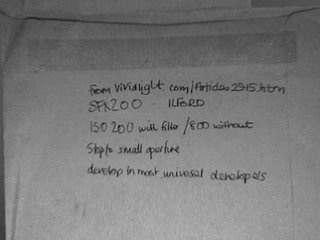So, the plan is to use up the rest of my B&W Film in the camera this weekend and to start shooting some IR next week.
Friday, 23 January 2009
Monday, 19 January 2009
Filter
I've had to buy a Filter from ebay as nobody has the right ones in stock and by the time I've ordered them and picked them up, the ebay one will be delivered.
It is a R72 IR filter.
Saturday, 17 January 2009
Filter
I have found the right filter, I just haven't got an adapter. I'll need to do some looking online for an adapter or a filter at a decent price as none of the shops had them in stock today.
Monday, 12 January 2009
Materials Analysis
Here I will research and analyse the effects that different materials have when recorded on IR film; trees/sky/grass/water/glass etc
The reason that IR images look 'false' is that the film captures the non-visible part of light, and the filter block blue wavelengths. The upshot is that some materials which reflect visible light do not reflect non-visible light [water, glass] and some that usually absorb visible light will reflect non-visible [grass, trees].
Historical Context - paper
Fibre papers have been used historically within photography for high quality fine art, exhibition or archiving purposes. It 'takes' the picture in a different way to popular photography paper as it colours to a depth, it doesn't just sit on top of the paper. For Black and White photography, it gives darker blacks and gives images a quality that isn't present in resin-coated papers. It also brings to life certain detail that just isn't captured in RC papers.
It also makes re-touching of images easier, and toning and handcolouring are also popular due to the 'arty' finish of the paper and the ease of manipulating the paper.
I want to use Fibre based paper for this project, as I want the blacks and whites captured by the IR film to be enhanced by the paper it is printed on.
The paper I'm using is Kentmere Document Art Grade 2.
Historical Context - IR film
Historically, IR film came into being around 1910, and was initially used by Robert Wood. It became a viable option once it was discovered that Silver Halide emulsions could be mixed with a dye to become sensitive to IR light.
Both colour and B&W are available. The colour has been used extensively during the 60s by artists such as Jimi Hendrix, to reflect the psychedelic aesthetic of the time. B&W has been used extensively throughout and is well known as a fine art technique with high contrasts. Colour has also been used to detect the presence of people by recording heat generated by a living body.
Filter
I'm going to need a Red filter for this film. Recommended filters are listed on the inside cover of the SFX 200 film box. I think I might have one of these already, as I inherited a box of filters a while back, so I'm going to search these out before I buy anything.
Buying the Film 2

I've bought the film. I have 3 rolls of 35mm and 1 roll of 120 - once I've customised the Holga to not absorb IR light - by covering in foil - I'll try some Holga shots as I am going through this project.
Friday, 9 January 2009
Buying the film 1
I've called Morco in Mansfield, and they have 3 rolls of the Ilford IR film in. they're open M-F, 9-5; so I'll pop over there next week and get it.
I'll look into the chemicals before hand in case I need to buy any additional materials.
A2 Fibre Optics
I am currently in year 2 of A Level Photography at Castle Col
This is the first post in my A2 Photography Personal Study.
lege, Nottingham.
The personal study that I have chosen is to take photographs using Infrared film, to develop the film and to print the images onto fibre based paper. I've chosen this because infrared measures reflected infrared energy, and records the image completely differently to 'regular' film. I have chosen fibre paper because it prints in more than one dimension, it has depths that 'regular' paper doesn't have.
I am first going to research the history of using infrared film, and the various methods of developing the film. I have already looked into the purchase of the film, and it seems that 35mm would be the easiest to use, although 120 film is available, it might not suit my Holga camera for this project [ the camera might need some work on it before it was keep out all the infrared light].
I am going to research online, and look at any specialists that work within the infrared spectrum.
I am going to look at [photographers]
I will be using the following equipment for this project.
A film camera, Ricoh XR-1 35mm, using a 50mm lens, Ilford SFX 200 film and an SFX 200 Cokin P series filter
I will decide on the developer chemicals once I have researched the film
I will use the college darkroom and develop the film there
I will use the college enlarger and developing suite, using [developer]
I will use Kentmere Fibre Paper to print
I will look to produce 6 finished prints, which will be framed and submitted.
All research, pre-work, contact sheets and printing will be scanned into this blog
Original course requirements:
Subscribe to:
Comments (Atom)

